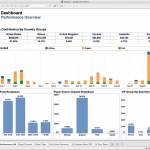Building Analytics Strategy for the Journey Ahead
In the world of business analytics, one of the most important things for you to understand is that there is truly no “one size fits all” approach to what you’re about to do. Every organization is a little bit different, so there is no one silver bullet strategy that will work equally well for every business. The key to success in this regard is to carefully consider not only where your organization is as it stands today, but where you hope it will be in five or even ten years from now. Then, you’ll be able to develop the right strategy to help make this journey as efficient and as successful as possible.
What Are You Focusing On?
The first step you need to take when building an analytics strategy for the journey ahead involves getting a better understanding of your larger business strategy within the strategic focal areas you need to work on.
Essentially, start by making a list of all the things that you want to achieve as a company in the next one to three years. Now, break it down further: what core business processes need to change in order to accomplish those things? What shape do those changes need to take? What ripple effects will they create all across your value chain?
The benefit of this is that it lets you break down your own business strategy into a series of smaller, more manageable parts. Then, based on the actual, tangible goals and objectives you have in front of you, you can begin building the right analytics vision to actually support those needs.
Source the Right Data
Another key thing to keep in mind when building an analytics strategy for the journey ahead involves not necessarily the data you’re working with, but where that data is coming from. Remember – not all data is created equally. The chasm between valuable and poor data is a deep one, indeed.
Because of this, you should not be afraid to source your data creatively. Remember that social media by its very design is generating massive amounts of data every day in the form of things like conversations between customers, images, videos and much more.
You’ll also need to take steps within your own organization to make sure that data is as integrated as possible. In terms of building an analytics strategy, data CANNOT exist in a silo. Legacy systems can often hold the key to a huge amount of invaluable insight, but it ultimately won’t do anyone any good if technology is creating an artificial barrier between the sales and marketing departments (for just one example).
Once you’ve sourced your quality data, make sure you have the IT support needed to actually integrate that data and make it available to as many people within your organization as possible.
Start Building Out Your Roadmap
Based on the steps you’ve already taken, you need to start defining more specific parameters for your analytics. Based on A) the data that you’ve sourced, and B) what you’re trying to accomplish, what metrics do you have to measure to connect the dots between those two points?
The answers will vary depending on your organization. If you were trying to develop an analytics strategy to help improve your marketing efforts, you might start tracking metrics like the amount of time people spend on your website. If you were trying to increase revenues by X% over Y number of years, you might start tracking key performance indicators like average purchase size, customer lifetime value and more.
The key is to begin tracking these KPIs now so that when you make changes to your business processes you can see the results they generate in real-time. Then, you can make necessary adjustments to your analytics strategy based on informed insight to help carry you farther down the line every day.








